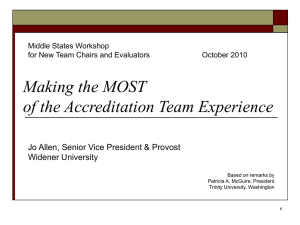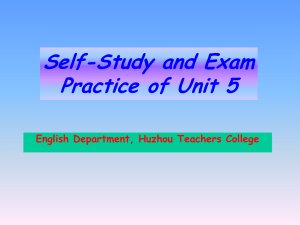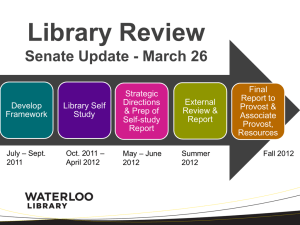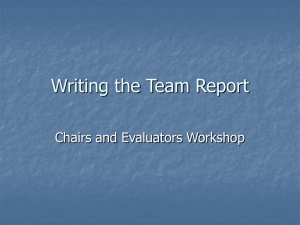Preparation of the Self-Study and Documentation
advertisement
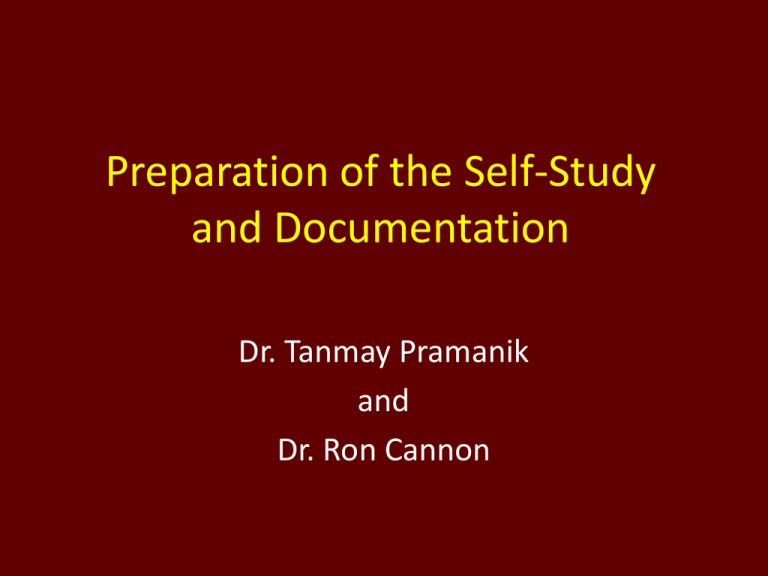
Preparation of the Self-Study and Documentation Dr. Tanmay Pramanik and Dr. Ron Cannon Moving from Applicant to Candidate Status Candidacy Process 1. Submission of Self-Study proposal and timeline a. TRACS President’s approval of Self-study Proposal and Timeline. b. TRACS staff visit to the institution to finalize timeline. c. Staff forms the on-site evaluation team. Moving from Applicant to Candidate Status 2. Self-Study sent to TRACS (minimum 3 months prior to visit) a. Audit received b. All supporting documentation received c. Visiting team travel deposit 3. Self-Study with documentation sent to team members by institution Moving from Applicant to Candidate Status 4. Team visit (minimum 3 months prior to the Commission meeting). 5. Team report a. Draft is submitted to TRACS via staff b. Draft is left with the institution for verification of fact c. Report goes through final editing d. Final report is sent to the institution Moving from Applicant to Candidate Status 6. Billing for team expenses and change of status fee. 7. Institutional response received (minimum 2 months prior to Commission meeting) Moving from Applicant to Candidate Status 8. Institution scheduled for Commission appearance (April or November) a. Grant candidate status without conditions (Candidate!) b. Grant candidate status with conditions (Candidate!) c. Defer candidate status to correct serious weaknesses d. Deny candidate status Steps To Accreditation 1. 2. 3. 4. 5. 6. Self-Study Proposal Organization of the Self-Study Team Timeline, Budget, and other Administrative Tasks Committee Work Self-Study Draft Approval of Self-Study Report by President and Board 7. TRACS Review of the Self-Study 8. TRACS Accreditation Visit 9. Candidate Status, Accreditation or Reaffirmation Self-Study Proposal A Self-Study Proposal must be completed and submitted to the TRACS office for review and approval before initiating the formal self-study process. Self-Study Proposal Format Introduction and brief history of the institution Purpose of the Self-Study Goals of the Self-Study Self-Study Timeline or Schedule Organization for the Self-Study • • • • Role and scope of the committee Names of the committees Membership of the committees Role and scope of the chairs of the committee Self-Study Proposal Format Materials and Resources Budget for the Self-Study Response to any/all previous Recommendations/Suggestions not completed Copy of the Institutional Plan and Assessment Mechanism as currently implemented The Organization of the Self-Study Team Self-Study Participants President Self-Study Director Editor Steering Committee Sub-Committees Timeline, Budget, and other Administrative Tasks Sample Self-Study Timelines Example One: 12-18 Months Oct - January January-April November Initiate the Self-Study at least 12-18 months prior to the desired completion of the SelfStudy. Complete the Self-Study and send to TRACS at least three months prior to the Team Visit. TRACS team visit must be scheduled no later than April. TRACS Accreditation Commission action. Agenda Steering Committee to meet to agree on the self-study process. Appointment of the Self-Study Director. Appointment of Steering Committee and Sub-Committees First Draft-Committees investigate, interview, analyze, and develop preliminary reports. Steering Committee reviews the first draft and gives feedback to the subcommittees. Second Draft-Committees incorporate input from the Steering Committee and submit Final Self-Study Report. Steering Committee compiles First Draft of Final Self Study Report Editor reviews and edits the First Draft of Final Self-Study Report President receives and reviews copy of the First Draft of Final Self-Study Report Steering Committee compiles Final Self-Study Report. Editor prepares the Final Self-Study Report for publication. President submits Final Self-Study Report to Board for approval President sends copies of Self-Study Report to TRACS & others. Date Committee Work Development of the Self-Study Report Two major categories: 1. Foundational Standards 2. Operational Standards Use of Assessment Data Self-Study Drafts The first draft of the Self-Study Report is compiled by the sub-committees. Upon review of the first draft of the Self-Study Report, the Steering Committee gives feedback to the sub-committees. The second draft of the report incorporates the additional input from the sub-committees and the steering committee. The steering committee will compile the Final SelfStudy Report. Self-Study Drafts Self-Study Report Format Most of the information can be provided in brief, narrative statements supported by charts, tables, and other primary documentation. The Self-Study Report should reflect the current status of the institution and long-term plans. A copy of the current Strategic Plan must be included. Every statement in the Self-Study Report must be documented and supported by analyzed assessment data. Self-Study Drafts Self-Study Report Format Materials to include with the Self-Study Report Self-Study Report narrative with attachments and documentation Catalog Student Handbook Faculty Handbook Financial Aid Manual Personnel Manual Self-Study Drafts Self-Study Report Format Materials to include with the Self-Study Report Board Manual Job Descriptions Strategic Planning Document Assessment Plan Policies and Procedures Manual Audit Approval of Self-Study Report by President and Board The President and Governing Board must review and approve the Self-Study Report prior to submission to the TRACS office. Minutes indicating the approval of the SelfStudy Report by the Board need to be included with the documentation. TRACS Review of the Self-Study Report The final Self-Study Report and all additional materials should be mailed to the TRACS office no later than three months prior to the desired accreditation visit. Upon receipt of the documents the TRACS office will review the package of materials for completeness. The final date for the accreditation visit, selection of team members, and travel details will be completed. TRACS Accreditation Visit Information concerning the details of a TRACS Accreditation visit is available in the TRACS Accreditation Manual. The visit brings the beginnings of closure to the Steering Committee. This is the opportunity for each of those who have worked carefully to develop a thorough and comprehensive document to affirm the contents of the report. Candidate (Pre-accredited) Status, Accreditation or Reaffirmation The Accreditation Commission meets twice a year (in April and November) to review the recommendations of the on-site evaluation team and the documents that have been submitted by the institution. The items that the Commission reviews in determining whether a school should be granted candidate , accredited or reaffirmed status include: Candidate (Pre-accredited) Status, Accreditation or Reaffirmation The institution’s Self-Study Report The on-site visiting team’s report The institution’s response to the team’s report The team chair’s letter to the Commission The Staff recommendation The Commission readers’ recommendation The institutions are required to send at least one representative to the Accreditation Commission meeting when action is being taken on that institution.

